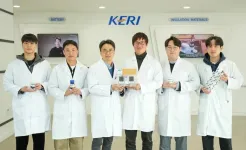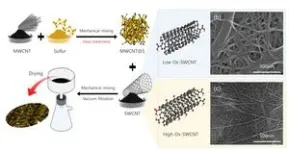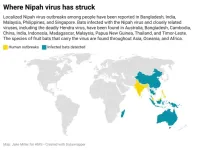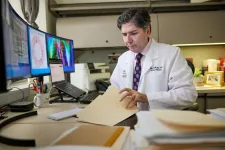(Press-News.org) Dr. Park Jun-woo's team at KERI's Next Generation Battery Research Center has overcome a major obstacle to the commercialization of next-generation lithium–sulfur batteries and successfully developed large-area, high-capacity prototypes.
The lithium–sulfur battery, composed of sulfur as the cathode (+) and lithium metal as the anode (-), has a theoretical energy density more than eight times that of lithium-ion batteries, demonstrating significant potential. Additionally, it uses abundant sulfur (S) instead of expensive rare earth elements, making it cost-effective and environmentally friendly. As a lightweight and long-lasting secondary battery, the lithium–sulfur battery is considered a key technological field to drive the era of urban air mobility (UAM).
However, the lithium–sulfur battery generates lithium polysulfides as intermediate substances during the charge and discharge processes. These substances shuttle between the cathode and anode, causing unnecessary chemical reactions that degrade the battery's lifespan and performance. This has been the biggest obstacle to the commercialization of lithium–sulfur batteries.
To address this, Dr. Park Jun-woo's team introduced an innovative technology combining single-walled CNT (SWCNT1)) with oxygen functional groups2). SWCNT is a next-generation material with strength surpassing steel and electrical conductivity comparable to copper, while the oxygen functional group enhances the dispersion of SWCNT within the battery. This SWCNT combined with oxygen functional groups stabilizes the electrode, which can expand during charge and discharge, and effectively controls the dissolution and diffusion of lithium polysulfides. Consequently, the loss of sulfur, the active material, was significantly reduced.
1) Carbon nanomaterials are characterized by their nanoscale conductivity and hexagonal carbon structure. These include graphene, a two-dimensional planar structure often referred to as a dream material, and CNT, which features a helical structure of graphene. Among them, CNTs are divided into multi-walled and single-walled types, with single-walled CNTs being thinner, more transparent, and offering superior properties and electrical conductivity.
2) Functional group: A group of atoms or a single atom with specific chemical and physical properties.
Additionally, the high flexibility of SWCNT and the hydrophilic (solvent-friendly) nature of the oxygen functional group allow for the creation of uniform and smooth surfaces during electrode fabrication, enabling the design of large-area, high-capacity batteries. As a result, the research team was able to produce a flexible thick electrode3) with dimensions of 50x60mm and successfully assemble it into a 1,000mAh (1Ah)4) pouch-type lithium–sulfur battery prototype. This prototype demonstrates high performance, maintaining over 85% of its capacity even after 100 charge-discharge cycles.
3) Thick electrode : To increase the energy density of a battery, the electrode should be thicker, which is referred to as a thick electrode.
4) mAh (milli Ampere hour) : This is a unit that represents the capacity of a battery, indicating the amount of current that can be used over the course of one hour. 1Ah is equivalent to 1,000mAh. Currently, commercial cordless vacuum cleaners and smartphones typically contain lithium-ion batteries with capacities around 2,000–4,000mAh.
Dr. Park Jun-woo stated, "Our technology has not only overcome the biggest challenge of the lithium–sulfur battery through the combination of SWCNT and oxygen functional groups, but also achieved the design and prototype development of large-area, high-capacity flexible electrodes. This is a comprehensive result." He added, "We have laid the foundational framework that can be applied in actual industrial settings, marking a significant achievement that opens up the practical commercialization potential of next-generation lithium–sulfur batteries."
The results of this research have been recognized for their excellence and published in *Advanced Science*, one of the world’s top journals in the field of materials science (first author Heo Jun-young, UST KERI Campus Ph.D. student; co-corresponding author Dr. Han Jung-tak; corresponding author Dr. Park Jun-woo). The paper’s *Impact Factor* is 14.3, placing it in the top 7.18%.
KERI, which has already completed a domestic patent application, anticipates that this achievement will attract significant interest from companies in industries such as urban air mobility, aerospace, ESS, and electric vehicles, where next-generation lithium–sulfur batteries are in demand. The goal is to identify potential clients and pursue technology transfer.
Meanwhile, KERI is a government-funded research institute under the National Research Council of Science & Technology (NST) of the Ministry of Science and ICT. This research was conducted as part of the 'Global Top Strategic Research Group' project (Strategic Research Group for Innovation in Market-Leading Next-Generation Secondary Batteries) and KERI's project (lithium–sulfur batteries). <KERI>
END
KERI, overcomes the biggest challenge of the lithium–sulfur battery, the core of UAM
2025-01-20
ELSE PRESS RELEASES FROM THIS DATE:
In chimpanzees, peeing is contagious
2025-01-20
A new study reported in the Cell Press journal Current Biology on January 20 is the first to describe a phenomenon researchers refer to as “contagious urinations.” The study in 20 captive chimpanzees living at the Kumamoto Sanctuary in Japan shows that, when one chimp pees, others are more likely to follow.
“In humans, urinating together can be seen as a social phenomenon,” says Ena Onishi of Kyoto University.
“An Italian proverb states, ‘Whoever doesn’t pee in company is either a thief or a spy’ (Chi non piscia in compagnia o è ...
Scientists uncover structure of critical component in deadly Nipah virus
2025-01-20
Scientists at Harvard Medical School and Boston University Chobanian & Avedisian School of Medicine have mapped a critical component of the Nipah virus, a highly lethal bat-borne pathogen that has caused outbreaks in humans almost every year since it was identified in 1999.
The advance, described Jan. 20 in Cell, brings scientists a step closer to developing much-needed medicines. Currently, there are no vaccines to prevent or mitigate infection with the Nipah virus and no effective treatments for the disease ...
Study identifies benefits, risks linked to popular weight-loss drugs
2025-01-20
Demand for weight-loss medications sold under brand names such as Ozempic and Wegovy continues to surge, with a recent study reporting one in eight Americans has taken or is currently using the drugs to treat diabetes, heart disease or obesity.
Formally, these drugs are known as glucagon-like peptide-1 receptor agonists (GLP-1RA) and include Mounjaro and Zepbound. Informally, media, patients and even some physicians have dubbed GLP-1 medications as “miracle drugs” because of the profound weight loss among users. While these health benefits are well established, information is sparse on the drugs’ effects across ...
Ancient viral DNA shapes early embryo development
2025-01-20
Over half of our genomes consists of thousands of remnants of ancient viral DNA, known as transposable elements, which are widespread across the tree of life. Once dismissed as the "dark side" of the genome, researchers at Helmholtz Munich and Ludwig-Maximilians-Universität (LMU) have now revealed their crucial role in early embryo development.
Unanswered Questions About the Role of Ancient Viral DNA
Transposable elements, remnants of ancient viral DNA, are reactivated during the first hours and days following fertilization. ...
New study paves way for immunotherapies tailored for childhood cancers
2025-01-20
Researchers at Karolinska Institutet and the Astrid Lindgren Children’s Hospital in Sweden have determined how children’s immune systems react to different kinds of cancer depending on their age. The study, which is published in the journal Cell, reveals significant differences between the immune response of children and adults, and has the potential to lead to new tailored treatments for children with cancer.
“The activation of the immune system is crucial to our ability to fight cancer, but differs between children and adults,” says Petter Brodin, professor of paediatric immunology at the ...
Association of waist circumference with all-cause and cardiovascular mortalities in diabetes from the National Health and Nutrition Examination Survey 2003–2018
2025-01-20
Background and objectives
Waist circumference (WC) is closely associated with metabolic diseases, including diabetes mellitus (DM), metabolic syndrome, and mortality. However, the correlation between WC and mortality varies across populations and has rarely been examined specifically in patients with DM. In this study, we explored the relationships between WC and both all-cause and cardiovascular mortalities among individuals with DM.
Methods
Participants from the National Health and Nutrition Examination Survey 2003–2018 included 3,151 women and 3,473 men with DM who had baseline WC measurements. Survival data were collected from enrollment until December 31, 2019. ...
A new chapter in Roman administration: Insights from a late Roman inscription
2025-01-20
Archaeologists have uncovered a rare Tetrarchic boundary stone at the site of Abel Beth Maacah in northern Israel. Originally marking land borders under Roman Emperor Diocletian’s tax reforms, the stone provides insight into ancient land ownership, local settlement patterns, and imperial administrative practices. The discovery also introduces two previously unknown place names, expanding our understanding of the region’s historical geography and socio-economic landscape.
Archaeologists Prof. Naama Yahalom-Mack and Dr. Nava Panitz-Cohen from the Institute of Archaeology at the Hebrew University, and Prof. Robert Mullins from Azusa Pacific University have uncovered a significant ...
Global trust in science remains strong
2025-01-20
A global survey spanning 68 countries reveals that public trust in scientists is still high. Led by the University of Zurich and ETH Zurich, a team of 241 researchers conducted the largest post-pandemic study of trust in science, societal expectations and public views on research priorities.
Trust in scientists is at a moderately high level worldwide, according to a new study. This is the conclusion of an international team of 241 researchers led by Viktoria Cologna of ETH Zurich and Niels G. Mede of the University of Zurich (UZH). “Our results show that most people in most countries have a relatively ...
New global research reveals strong public trust in science
2025-01-20
A new international study on public trust in science, conducted across 68 countries, has found that most people trust scientists and believe they should be more involved in society and policymaking. Further, a majority of survey participants believe that scientists should be more involved in society and policymaking.
Published in Nature Human Behaviours (pre print link), this research was conducted by TISP, a Harvard University-based consortium led by Dr Viktoria Cologna (Harvard University, RTH Zurich) and Dr Niels G Mede (University of Zurich), which includes 241 researchers from 169 institutions worldwide, including the University of Bath.
The study, which includes 71,922 respondents—2,008 ...
Inflammation may explain stomach problems in psoriasis sufferers
2025-01-20
People with the skin condition psoriasis often have invisible inflammation in the small intestine with an increased propensity for ‘leaky gut’, according to new research at Uppsala University. These changes in the gut could explain why psoriasis sufferers often have gastrointestinal problems and are more prone to developing Crohn’s disease. The study is published in Biochimica et Biophysica Acta (BBA) – Molecular Basis of Disease.
Psoriasis is a hereditary, chronic skin condition that can also result in inflammation of the joints. In Sweden, almost 300,000 people live with some form of the condition. Chronic inflammatory bowel ...







